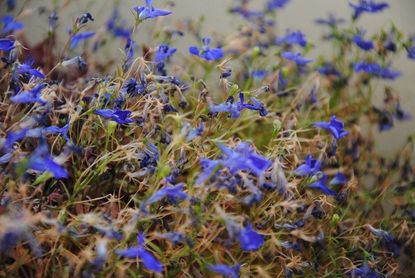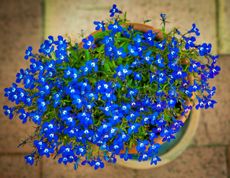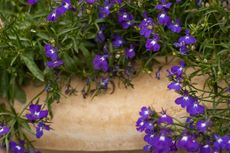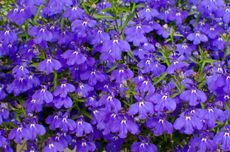Lobelia Browning: Why Lobelia Plants Turn Brown


Lobelia plants make beautiful additions to the garden with their unusual flowers and bright colors, but problems with lobelia can result in brown lobelia plants. Lobelia browning is a common problem with many different causes. Careful observation and this list of common causes of lobelia browning will help you understand what's causing your lobelia trouble.
Why Lobelia Plants Turn Brown
Below are the most common reasons for brown lobelia plants.
Environmental Issues
Brown plant tissues are often the result of tissue death, both big and small. When cells are no longer able to receive nutrients from their transport tissues, they wither and collapse. Many different problems can interfere with these transport mechanisms, but always check your plant's growing conditions first -- often under or over watering is to blame. Underwatering may be an obvious cause, but overwatering may make less sense until you realize that under these conditions, plants suffer significant root death, decreasing the amount of fluid and nutrients they can bring to their tissues. Lobelias don't care for heat or drought; their transport tissues aren't designed to function under extreme heat so leaves often brown and curl up from the outer edge inward when it's too hot. Lobelia with brown leaves but healthy stems may have been exposed to too much sun or simply not watered enough. Move these plants to a part-shade location and increase watering. New, healthy leaves will show you that you're on the right track.
Pests and Disease
Fungal problems and pests can be responsible for browning as well, especially if they feed inside the plant or directly from cells. External pests and parasitic fungi are easy to detect, but those living inside formerly healthy tissues can be harder to control. Rust is a common external fungus on lobelia. This disease usually starts on leaf tissues, quickly covering them in orange, brown, or dark-colored spores. Pick off a few diseased leaves or treat widespread rust with neem oil sprays; if you act quickly you should be able to reverse the disease's progression. In the future, allow your lobelia more room to breathe -- good air circulation can prevent many fungal problems. Lobelias have few pest problems, but mites are among the worst. Mites feed on leaves, sucking the juices out of individual cells, which results in cell death and leaves tiny, brown spots on leaf surfaces. As these mite colonies spread, the brown dots grow into one another, giving leaves an overall bronze or brown appearance. Spray mites with neem oil or insecticidal soap weekly until new growth doesn't show any signs of damage. If your plants are browning from the base upward, you may have a sinister pest known as the corn earworm. These larvae bore a hole in the base of lobelia stems and feed inside, eventually hollowing the stem completely. As they feed, severing transport tissues, the leaves and stem slowly brown and collapse. Other corn earworms may move into different stems, causing their collapse. Before giving up on these plants, cut out damaged areas. Once larvae are inside it's hard to treat them, but preventative sprays of acephate around the base of unharmed stalks can prevent infestation.
Gardening tips, videos, info and more delivered right to your inbox!
Sign up for the Gardening Know How newsletter today and receive a free download of our most popular eBook "How to Grow Delicious Tomatoes."

Kristi Waterworth was a regular contributor to Gardening Know How for many years, answering countless queries on plant pests and diseases.
-
 How To Get Rid Of Mosquitoes In The Garden: 9 Natural Ways To Make Them Buzz Off!
How To Get Rid Of Mosquitoes In The Garden: 9 Natural Ways To Make Them Buzz Off!How to get rid of mosquitoes is on the minds of people in the summer in almost every region of the world. Learn how to repel the pests without toxic chemicals.
By Mary Ellen Ellis
-
 Monkey Orchid Care: How To Grow This Fascinating Species
Monkey Orchid Care: How To Grow This Fascinating SpeciesThe monkey orchid bears a remarkable resemblance to its namesake and, with a little know-how, can be successfully grown as a houseplant.
By Bonnie L. Grant
-
 Lobelia Winter Care – Tips For Overwintering Lobelia Plants
Lobelia Winter Care – Tips For Overwintering Lobelia PlantsThere are many types of Lobelia. Some are annuals and some are perennials. Lobelia winter hardiness varies by species, but even the hardy Lobelias need special care to survive cold temperatures. Click this article for important tips on Lobelia winter care.
By Bonnie L. Grant
-
 Potted Lobelia Care: Tips For Growing Lobelia In Containers
Potted Lobelia Care: Tips For Growing Lobelia In ContainersWhile cardinal lobelia is most often grown as a perennial, other types are treated as annuals for the spring and the summer garden, an asset when planning ornamental containers for landscapes and front porches. Click here to learn more about potted lobelia care.
By Tonya Barnett
-
 Cutting Back Lobelia: When Should I Prune My Lobelia Plants
Cutting Back Lobelia: When Should I Prune My Lobelia PlantsLobelia flowers make a lovely addition to the garden but like many plants, pruning is an important part of keeping lobelia plants looking their best. Find out how and when to trim lobelia in this article to ensure your plants look their best.
By Jackie Carroll
-
 Lobelia Care Guide: How To Grow Edging Lobelia
Lobelia Care Guide: How To Grow Edging LobeliaA lovely herb plant with bright blue to purple blossoms, the trailing lobelia flower is a perfect choice for filling in around garden beds, driveways and borders. It’s easy to grow and, depending on your zone, can be an annual or perennial.
By Nikki Tilley